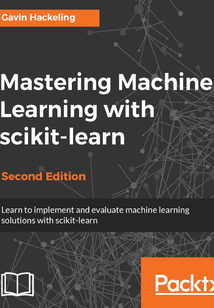舉報 

會員
Mastering Machine Learning with scikit-learn(Second Edition)
最新章節:
Summary
Thisbookisintendedforsoftwareengineerswhowanttounderstandhowcommonmachinelearningalgorithmsworkanddevelopanintuitionforhowtousethem,andfordatascientistswhowanttolearnaboutthescikit-learnAPI.FamiliaritywithmachinelearningfundamentalsandPythonarehelpful,butnotrequired.
目錄(147章)
倒序
- coverpage
- Title Page
- Credits
- About the Author
- About the Reviewer
- www.PacktPub.com
- Why subscribe?
- Customer Feedback
- Preface
- What this book covers
- What you need for this book
- Who this book is for
- Conventions
- Reader feedback
- Customer support
- Downloading the example code
- Errata
- Piracy
- Questions
- The Fundamentals of Machine Learning
- Defining machine learning
- Learning from experience
- Machine learning tasks
- Training data testing data and validation data
- Bias and variance
- An introduction to scikit-learn
- Installing scikit-learn
- Installing using pip
- Installing on Windows
- Installing on Ubuntu 16.04
- Installing on Mac OS
- Installing Anaconda
- Verifying the installation
- Installing pandas Pillow NLTK and matplotlib
- Summary
- Simple Linear Regression
- Simple linear regression
- Evaluating the fitness of the model with a cost function
- Solving OLS for simple linear regression
- Evaluating the model
- Summary
- Classification and Regression with k-Nearest Neighbors
- K-Nearest Neighbors
- Lazy learning and non-parametric models
- Classification with KNN
- Regression with KNN
- Scaling features
- Summary
- Feature Extraction
- Extracting features from categorical variables
- Standardizing features
- Extracting features from text
- The bag-of-words model
- Stop word filtering
- Stemming and lemmatization
- Extending bag-of-words with tf-idf weights
- Space-efficient feature vectorizing with the hashing trick
- Word embeddings
- Extracting features from images
- Extracting features from pixel intensities
- Using convolutional neural network activations as features
- Summary
- From Simple Linear Regression to Multiple Linear Regression
- Multiple linear regression
- Polynomial regression
- Regularization
- Applying linear regression
- Exploring the data
- Fitting and evaluating the model
- Gradient descent
- Summary
- From Linear Regression to Logistic Regression
- Binary classification with logistic regression
- Spam filtering
- Binary classification performance metrics
- Accuracy
- Precision and recall
- Calculating the F1 measure
- ROC AUC
- Tuning models with grid search
- Multi-class classification
- Multi-class classification performance metrics
- Multi-label classification and problem transformation
- Multi-label classification performance metrics
- Summary
- Naive Bayes
- Bayes' theorem
- Generative and discriminative models
- Naive Bayes
- Assumptions of Naive Bayes
- Naive Bayes with scikit-learn
- Summary
- Nonlinear Classification and Regression with Decision Trees
- Decision trees
- Training decision trees
- Selecting the questions
- Information gain
- Gini impurity
- Decision trees with scikit-learn
- Advantages and disadvantages of decision trees
- Summary
- From Decision Trees to Random Forests and Other Ensemble Methods
- Bagging
- Boosting
- Stacking
- Summary
- The Perceptron
- The perceptron
- Activation functions
- The perceptron learning algorithm
- Binary classification with the perceptron
- Document classification with the perceptron
- Limitations of the perceptron
- Summary
- From the Perceptron to Support Vector Machines
- Kernels and the kernel trick
- Maximum margin classification and support vectors
- Classifying characters in scikit-learn
- Classifying handwritten digits
- Classifying characters in natural images
- Summary
- From the Perceptron to Artificial Neural Networks
- Nonlinear decision boundaries
- Feed-forward and feedback ANNs
- Multi-layer perceptrons
- Training multi-layer perceptrons
- Backpropagation
- Training a multi-layer perceptron to approximate XOR
- Training a multi-layer perceptron to classify handwritten digits
- Summary
- K-means
- Clustering
- K-means
- Local optima
- Selecting K with the elbow method
- Evaluating clusters
- Image quantization
- Clustering to learn features
- Summary
- Dimensionality Reduction with Principal Component Analysis
- Principal component analysis
- Variance covariance and covariance matrices
- Eigenvectors and eigenvalues
- Performing PCA
- Visualizing high-dimensional data with PCA
- Face recognition with PCA
- Summary 更新時間:2021-07-02 19:01:34
推薦閱讀
- WebAssembly實戰
- AIRAndroid應用開發實戰
- 跟老齊學Python:輕松入門
- Java開發入行真功夫
- The Data Visualization Workshop
- Python時間序列預測
- 可解釋機器學習:模型、方法與實踐
- Building Machine Learning Systems with Python(Second Edition)
- Python項目實戰從入門到精通
- Mastering Python Design Patterns
- Android傳感器開發與智能設備案例實戰
- Geospatial Development By Example with Python
- QGIS 2 Cookbook
- Android智能手機APP界面設計實戰教程
- 高性能PHP 7
- Java EE 程序設計
- 新手學ASP.NET 3.5網絡開發
- Java程序性能優化實戰
- Flutter for Beginners
- TensorFlow程序設計
- Java性能權威指南
- VB語言程序設計教程(第2版)
- Java面向對象程序設計(第3版)
- C/C++程序設計:計算思維的運用與訓練
- React 16 Essentials(Second Edition)
- JavaScript Promises Essentials
- Web前端學習筆記:HTML5+CSS3+JavaScript
- Python網絡編程(原書第2版)
- Java編程從零開始學(視頻教學版)
- Apache Spark 2:Data Processing and Real-Time Analytics

